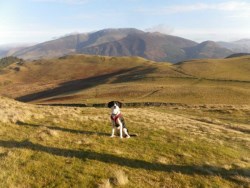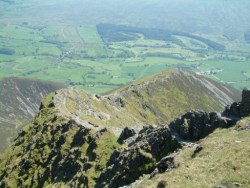Cycling
If you want a cycling holiday touring the whole of the park, or just want to explore on two wheels for a day, the Lake District has bridleways, cycleways. quiet country lanes, road routes for road cyclists and off road tracks for mountain bikers. You can bring your own bike, or there places to hire bicycles in most of the areas.
Whatever your fitness level or cycling ability you'll find a cycling route for you. Mountain bikers will enjoy the challenge of extreme hill climbing. If you want a gentler route then there are cycleways along disused railway lines. Road cyclists wanting a challenge may want to try the 1 in 3 climb at Wrynose Pass!

Join us on
Please visit the Sitemap to see the full range of information on this site
MountainWalk.co.uk is produced by Trish Haill Associates Copyright
Have you climbed Ben Nevis, Snowdon or Scafell Pike? Or taken part in the Three Peaks Challenge? Or have a special walk you'd like to share? We'd love to here from you! Join us on Facebook or Send us an email.
Outdoor Activities in the Lake District
The variety of different terrains and the sheer beauty of the English Lake District make it the ideal place for outdoor activities. People head there for a day, a weekend or a longer holiday to take advantage of the recreational and sporting activities on offer.
Whether you are an expert or novice, the facilities in the Lake District National Park will have something to offer you either as an introduction, or as a challenge.
You can take advantage of the numerous outdoor activity centres, or just do it alone. A holiday in the area gives you the chance to try something new.
You can take advantage of the numerous outdoor activity centres, or just do it alone. A holiday in the area gives you the chance to try something new.
On this page:
Walking and Hiking
Rock Climbing in the Lake District
Lakes and Watersports
Fishing and Fishing Permits
Wild Swimming
Cycling
Walking and Hiking
Rock Climbing in the Lake District
Lakes and Watersports
Fishing and Fishing Permits
Wild Swimming
Cycling
Walking and Hiking
Almost everyone who visits the Lake District will do some walking whilst there.
Some people will want to scale the heights of the highest mountain in England, Scafell Pike. Some people will want to follow in the footsteps of Alfred Wainwright and start ticking off each of the 214 peaks in the walks that he described, visiting the area again and again until they have achieved their goal.
Almost everyone who visits the Lake District will do some walking whilst there.
Some people will want to scale the heights of the highest mountain in England, Scafell Pike. Some people will want to follow in the footsteps of Alfred Wainwright and start ticking off each of the 214 peaks in the walks that he described, visiting the area again and again until they have achieved their goal.
Ice glaciers melting in the last ice age caused the deep valleys which became filled with water to form the lakes which give the area its name, and left the high peaks that make up the landscape familiar to us today and provides sufficient varied challenges for every walker - whatever levels of fitness or experience. In total there are well over 300 fells to be climbed ranging in height from Humphrey Head at just 172 ft (53 metres) to Scafell Pike itself standing 3,120 ft hight (978 metres). People have come to walk the fells and valleys for over two hundred years, and to accommodate the walkers free access to the fells has become a tradition. The Lake District is criss crossed with public footpaths and rights of way.
Wainwright Books
You can buy the full set of Wainwright Books on Amazon, but at around £65 for the set you might want to think about buying these second hand. The Wainwright guides are still the most popular guides to walking in the Lake District, so are well worth the investment. You may be able to buy the guides cheaper on Ebay.

Sale Fell (picture courtesy of Ruth Akers)
Easy to Moderate Walks
Although the Lake District is famed for its mountains and peaks, there are many walks which circle many of the lakes, and which are interesting and scenic routes allowing enjoyment of the variety of scenery on offer without proving too taxing. Many of these walks are described at (and can be downloaded for free) from The Walking Englishman.
Lake District walks for those who are less active or have limited mobility
There are walking routes for everyone, whether travelling solo or with young children for example, and suitable for a wide range of fitness levels. The National Park caters for people with limited mobility, people who are less active or who are visually impaired. There are 42 routes which are suitable for wheelchairs and pushchairs. Find out more iinformation about the Miles without Stiles routes.
There are walking routes for everyone, whether travelling solo or with young children for example, and suitable for a wide range of fitness levels. The National Park caters for people with limited mobility, people who are less active or who are visually impaired. There are 42 routes which are suitable for wheelchairs and pushchairs. Find out more iinformation about the Miles without Stiles routes.
Maps and Books
Unless you are walking on a very simple path, it is always wise to invest in a map and compass. If you've not tried navigating before, now's the time to try, and not only might you have some fun with it, but if you are halfway up a mountain and the fog comes down, it might save your life! Learn more about using a map and compass via this link.
Rock Climbing in the Lake District
The Lake District is where the sport of rock climbing in the UK was born in the late nineteenth century. As with the options for walking, there is a type of terrain for everyone, whether you are an expert or a beginner. The climbs are graded into levels of difficulty.
If you are new to the sport but have been considering taking up rock climbing then there are a number of centres and courses around the Lake District which you could go on whilst you're holidaying in the area. The centres will be able to provide you with the right equipment and teach you the techniques to keep you safe. Safety in rock climbing is taken very seriously.

Picture by Ady Gray
Experienced climbers are spoilt for choice, with climbs to suit all skill levels even for an experienced mountaineer. The crags in the main valleys lend themselves to spectacular rock climbs - the rock surfaces are varied as well, including granite, sandstone, slate and limestone.
There are walking routes up Blencathra (pictured right) which involve some serious scrambling - Wainwright referred to Blencathra as "a mountaineers mountain".
There are walking routes up Blencathra (pictured right) which involve some serious scrambling - Wainwright referred to Blencathra as "a mountaineers mountain".
As well as mountains the Lake District obviously has - lakes! But not as many 'lakes' as you might think. In fact the only official 'lake' is Bassenthwaite Lake. Most of the others are named meres or water, e.g. Windermere, Derwent Water, and there are also a number of tarns.
You may be asking the question, what's the difference between a lake, a mere and a water? And you wouldn't be alone. There are some definitions of 'mere' which suggests that it's a lake which is broad and not particularly deep, or that it is simply a body of standing water which doesn't move - that is, it is not fed by a stream. Others say there is no identifiable difference but that the different words have just arisen from the way language has developed. Tarns tend to be smaller lakes higher up in the fells. A tarn is formed when a glacier leaves behind a bowl like shape which then becomes filled with water. Although the name 'tarn' tends to be used for the smaller lakes higher in the fells, all the lakes in the Lake District could fit this definition.
Whatever and why ever the lakes are called what they are, there are a lot of them. There are 20 major lakes and several tarns. Popular watersports include water skiing, wakeboarding, sailing, canoeing, kayaking, rowing, motor boats and of course, fishing.
Families are well catered for on the larger lakes - boat trips make a good outing for a family with children, or you can hire your own motor boat for a day and cruise at your own pace. Lake Windermere, for example, has many public jetties where you can stop off and explore the area. Or you can to for a lake cruise on a steam boat on Ullswater.
You may be asking the question, what's the difference between a lake, a mere and a water? And you wouldn't be alone. There are some definitions of 'mere' which suggests that it's a lake which is broad and not particularly deep, or that it is simply a body of standing water which doesn't move - that is, it is not fed by a stream. Others say there is no identifiable difference but that the different words have just arisen from the way language has developed. Tarns tend to be smaller lakes higher up in the fells. A tarn is formed when a glacier leaves behind a bowl like shape which then becomes filled with water. Although the name 'tarn' tends to be used for the smaller lakes higher in the fells, all the lakes in the Lake District could fit this definition.
Whatever and why ever the lakes are called what they are, there are a lot of them. There are 20 major lakes and several tarns. Popular watersports include water skiing, wakeboarding, sailing, canoeing, kayaking, rowing, motor boats and of course, fishing.
Families are well catered for on the larger lakes - boat trips make a good outing for a family with children, or you can hire your own motor boat for a day and cruise at your own pace. Lake Windermere, for example, has many public jetties where you can stop off and explore the area. Or you can to for a lake cruise on a steam boat on Ullswater.
Lakes and Watersports
Fishing and Fishing Permits
If you want peace and quiet and time to relax and enjoy the scenery then you may want to take part in what is a very popular pastime in the Lake District - fishing! Popular lakes for fishing are Windermere, Basssenthwaite Lake (where you can watch out for Ospreys in season) and Buttermere, but there are numerous rivers and lakes which you can choose from, and wherever you go you can be assured that you will have fantastic views to enjoy while you wait for your catch.
Wild Swimming
The Lake District National Park, with it's many and varied bodies of water, has a great range of opportunities for wild swimming. You must research the area first, but you will be able to find places when you can dive or jump such as deep tarns. There are beaches to swim from and waterfalls and gorges to swim through. If you want to know more about the best places to swim then visit Wild Swimming.
See the other Lake District Guides
The Wainwrights
Windermere and the Southern Lakes
Kendal and District
Keswick and the North Lakes
Coast and Western Lakes
Penrith and the Eastern Lakes
Ulverston and South West Cumbria
The Wainwrights
Windermere and the Southern Lakes
Kendal and District
Keswick and the North Lakes
Coast and Western Lakes
Penrith and the Eastern Lakes
Ulverston and South West Cumbria
Rivers in the Lake District are well stocked with salmon, sea trout and brown trout, and there is good coarse fishing in the larger lakes. Permits are not needed at Ullswater, Consiton Water or Windermere, but in other places you will require a fishing permit.
If you are new to fishing you will need a rod licence anywhere that you fish for salmon, trout or freshwater fish if you are over the age of 12. These licences can be obtained from the Environment Agency online, or at a Post Office. You can buy them elsewhere but may incur an extra charge. Most permits for fishing in the lakes cost £8 per day - game fishing is £18 per day. You can buy permits online and get details of where to fish at LakeDistrictFishing.
Many places in the Lake District have professional instructors if you are new to the sport.
If you are new to fishing you will need a rod licence anywhere that you fish for salmon, trout or freshwater fish if you are over the age of 12. These licences can be obtained from the Environment Agency online, or at a Post Office. You can buy them elsewhere but may incur an extra charge. Most permits for fishing in the lakes cost £8 per day - game fishing is £18 per day. You can buy permits online and get details of where to fish at LakeDistrictFishing.
Many places in the Lake District have professional instructors if you are new to the sport.

